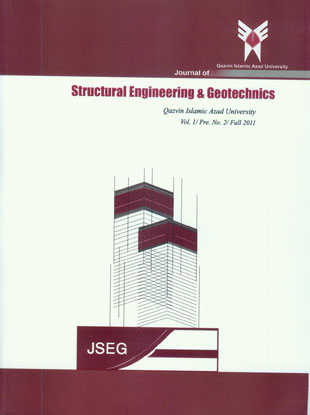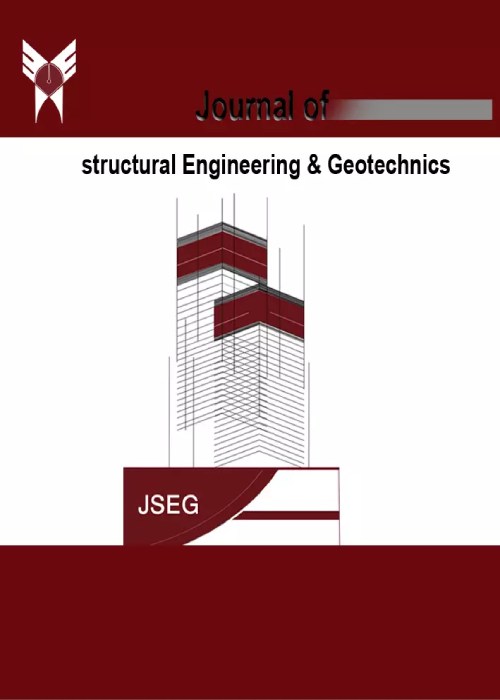فهرست مطالب

Journal of the Structural Engineering and Geotechnics
Volume:1 Issue: 2, Autumn 2011
- تاریخ انتشار: 1391/02/25
- تعداد عناوین: 8
-
Page 1The hydraulic pressure is one of the most important factors in the design of pressure intake tunnels. Since the surrounding media cannot usually resist the high internal pressure of these tunnels, they are usually finished with an adequate lining mostly of reinforced concrete, which is an interaction problem between water, soil or rock and concrete lining. Although reinforcing the concrete lining may reduce the width and number of the developed cracks in the lining, the penetration of water into the surrounding media can still happen due to high water pressure in the tunnel. Thus, it may lead to the development of hydro pressure on the external surface of the lining. There are some theoretical methods that are developed for the design of tunnel lining in this condition. When the tunnel is located above the underground water table, the seeping water may lead to strength reduction of the adjacent soils, particularly when the ground, like the mudstone layers existing in Dasht-e-Abbas region, south-west of Iran, is cohesive and consists of soils that are susceptible to water. In this paper, the hydrostatic interaction between soil and concrete lining of Dasht-e-Abbas pressure intake tunnel has been investigated when the shear strength parameters of the mudstone layers decrease due to the seepage of water to the surrounding media. To evaluate the stability of the tunnel, a two dimensional numerical simulation is developed using the finite element code called PLAXIS and interaction analyses are carried out. The analyses are done in stages to assess the maximum internal forces induced in the lining. The structural stability of the tunnel is evaluated and discussed in this condition. Based on the obtained results, it is noted that for more realistic understanding of the behavior of infrastructures like pressure intake tunnels under various conditions, numerical analyses should also accompany experimental and analytical approaches such as Schleiss method which is described in this paper, especially for tunneling in media that is susceptible to water and ground strength reduction. The numerical analysis results show a considerable increase in the lining internal forces when subjected to the reduction of ground strength. However, the tunnel structure is still stable under the effect of surrounding ground degradation with the constructed lining specifications.
-
Page 11In this paper, a structural damage identification method (SDIM) is developed for plate-like structures. This method is derived using dynamic equation of undamaged/damaged plate, in which local change in flexural rigidity is characterized utilizing a damage distribution function. The SDIM requires to modal data in the intact state and frequency response of damage state where most of vibration based damage identification techniques requires to modal data in both states. Change of mode shapes of damaged plate are approximated as a linear combination of mode shapes of intact plate and are considered in dynamic equation of damaged plate. Constant Coefficients of linear combination have been evaluated using perturbed equation of motion and the damage distribution function. Two strategies for making the inverse problem damage identification are introduced in connection with damage the present SDIM: (1) by using sensitivity of natural frequencies and (2) by using FRF-data, a sufficient number of equations can be derived to detect magnitude and location of damage. The feasibility of presented method is validated through some numerically simulated damage identification test taking into account random noise in FRF-data.
-
Page 17With the growing population and density in metropolitan areas, higher tendency to live in high-rise buildings, and increasing demand for parking lots, it seems necessary to excavate soil to construct underground spaces. During excavation work, as the height of the wall increases, special care should be taken to the wall stabilization to avoid any consequent damage including extensive property damage or loss of life. Different methods such as performing steel or concrete pile, sheet piling, reciprocal anchorage, diaphragm wall, soil nailing, and soil anchorage can be utilized to stabilize excavation wall. As all of these methods have their own advantages and disadvantages, it is important to know the limitations and differences of each method. Besides providing more work space in the wall, using novel methods of stabilization may lead to considerable savings in cost and time. By examining the behavior of retaining structure and also predicting the value of wall displacement, resulting from existing loads such as adjacent structures of the wall, service loads, and vehicle live load, a big step can be taken to prevent any probable damage. Currently, due to the development of high speed digital computers, finite element method (FEM) can be applied to predict the behavior of retaining structure. In this paper, as a case study, the behavior of retaining structure of excavation wall of Narges Razavi 2 International Hotel, Mashhad, stabilized using steel pile and soil anchorage, has been investigated. For this purpose, the results obtained from finite difference software, FLAC2D, and finite element software, PLAXIS2D, have been compared with those obtained from the monitoring of excavation wall. It was found that there is a good consistency between the results.
-
Page 25The Welding in cold formed areas is not only an open question for statically loaded sections (brittle fracture) but also for dynamically loaded structures (fatigue resistance). A lot of structures are subjected to dynamic loadings and unfortunately very little information about the influence of welding in the cold formed areas on fatigue resistance is available. In order to establish the fatigue behavior of welded and non-welded rectangular hollow sections specimens, a large number of 4-point bending tests are performed at the Saud Bin Laden Group SBG with cooperation with Buro Happold UK, Laboratory for Steel. Because these tests are very expensive, and because of the large number of parameters regarding the RHS to be investigated (steel grade, wall thickness, load distribution, boundary conditions), a number of finite element models for these specimens are made. By modeling the specimens with different types of finite elements (shells, solids) and taking into account some types of loading distributions and boundary conditions, the obtained results (stresses, strains, displacements) from a static analysis are compared with those obtained from the real 4-points bending tests. In this way, the obtained conclusions would lead to decrease of the number of the specimens that need to be tested as well as the costs of the project. Furthermore, by using finite element analysis, many factors with direct influence on the fatigue resistance can be considered.
-
Page 29There are various parameters that affect stability and expansion of failure zones in under pressure tunnels. Among the important parameters that affect failure zones around the tunnels are cohesion and internal friction angle of the rock mass. In addition, the cross sectional shape is the considerable point in failure distribution around the tunnels. The stress analysis method is one of the applicable methods for evaluating stability and recognizing failure zones in underground tunnels. On the other hand, numerical stress analysis method, because of obtaining results with simplicity and desirable accuracy, is one of the best methods in stability evaluation of the tunnels. The Boundary Element Method (BEM) has unique advantages in stability analysis of infinite continuums. In this paper, using Hoek-Brown failure criteria and also BEM, failure zones around the tunnels with various section shapes are studied numerically and the effects of cohesion and internal friction angle of rock mass on formation and distribution of failure radii are evaluated. It deserves mentioning that the behavior of the rock mass around the tunnels is assumed to be elastic and the formulations are based on plane strain.
-
Page 39This study aims to investigate the effects of geometric imperfections on buckling of thin cylindrical shells due to global shear. To this end, more than 320 finite element models of cylindrical shells with different diameter to thickness ratios were prepared. Random imperfections with different amplitudes were applied to numerical models. The results revealed that global buckling of cylindrical shells are susceptible to imperfection patterns. It was also shown that Yamaki’s expression can be considered as upper band for plastic shear buckling of thin cylindrical shells.
-
Page 45This paper addresses the problem of quantifying the mechanical contribution of rockbolts installed systematically around tunnels (regularly spaced around the tunnel) excavated in rock masses. Assuming that the mechanical contribution of grouted rockbolts is that of increasing internal pressure within a broken rock mass, a new procedure for computation of ground response curves for a circular tunnel excavated in strain softening material and then reinforced with systematically active grouted rockbolts is presented. In this work, the equation of the ground response curve for a tunnel which has been reinforced with passive grouted rockbolts is also derived. The proposed model allows one to take into account the effect of the distance of the bolted section to the tunnel face, the effect of increasing rockbolts spacing, the influence of increasing pretension load in calculating of the ground response curve, and the effect of increasing the cross-section area of rockbolts. The results show that decreasing rockbolts spacing increases the support system stiffness rather than preloading of them.
-
Page 57Waste tires, rubbers, plastic and steel materials, normally produced in every society, enter the environment and cause serious problems. These problems may, to some extent, be reduced by finding applications for them in engineering, for example, they can be used for geotechnical applications as backfill material and solving problems with low shear strength soils. Such materials may be subjected to freeze-thaw cycles, resulting in strength reduction. Freeze–thaw cycling is a weathering process which is normal in cold climates. In these cycles, thermodynamic conditions at temperatures below C cause translocation of water and ice which can change the engineering properties of soils. The present study investigates the effect of reinforcing soil with tire chips and steel fibers to reduce the effects of freeze-thaw cycles. To this aim, reinforced kaolinite clay was compacted in the laboratory and exposed to a maximum of 6 closed-system freeze-thaw cycles. The results of the study reveal that adding tires to clay prevents strength reduction due to freeze-thaw cycles. The soil samples which were mixed with 2% of steel fibers and 10% of tire chips were not affected by the freeze and thaw cycles as the pure samples were. These materials can reduce the effects of freeze and thaw cycles especially in cold regions.


